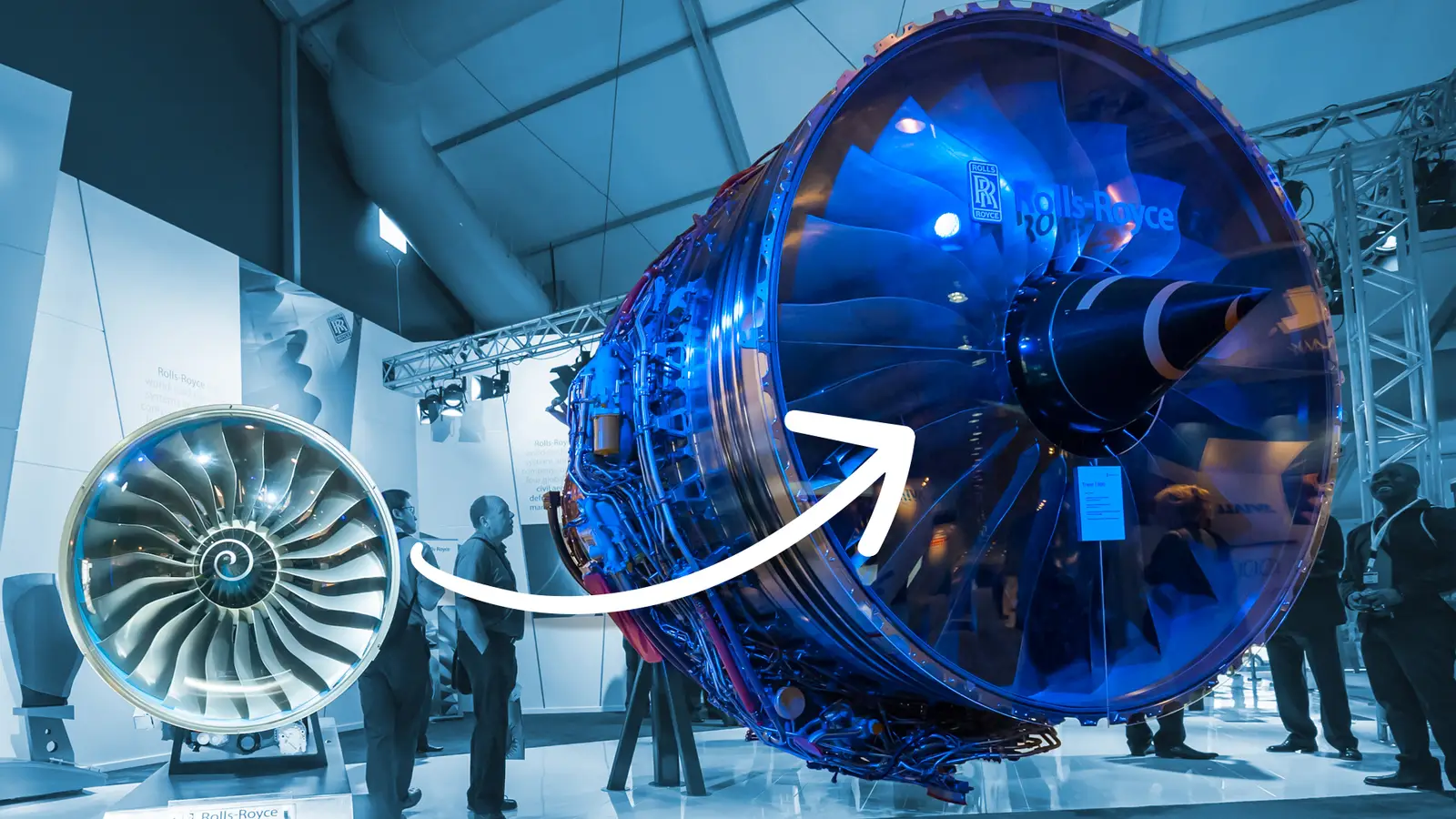
When it comes to modern widebody aircraft, engines are the true workhorses that determine efficiency, reliability, and long‑term success. Two of Rolls‑Royce’s most important powerplants of the past two decades, the Rolls Royce Trent 1000 and the Trent XWB , illustrate how lessons learned from one program can shape the triumph of another. In this guide, we’ll explore the striking differences between these two engines, from their design philosophies and operational histories to their performance, reliability, and future outlook.
The Trent 1000, developed for the Boeing 787 Dreamliner, entered service in 2011 but soon faced durability and reliability challenges that tarnished its reputation. By contrast, the Trent XWB, designed exclusively for the Airbus A350, has become the most reliable and efficient large aero engine in service today. Understanding the differences between these two engines not only sheds light on Rolls‑Royce’s engineering journey but also offers valuable lessons for the future of civil aviation.
Development Histories: Two Very Different Journeys
The Trent 1000 was commissioned in the early 2000s as one of two engine options for Boeing’s revolutionary 787 Dreamliner. Rolls‑Royce competed against GE’s GEnx, and both were tasked with meeting Boeing’s ambitious targets for fuel burn and weight. Boeing insisted that neither manufacturer “oversize” their engines, a decision that would later prove costly.
As the 787‑9 variant grew heavier during development (up to ~560,000 lb / 254,000 kg), the engine was stressed beyond its original envelope. This left the Trent 1000 operating with very little margin, and as a consequence,high-pressure turbine blades and compressor components experienced fatigue, and resonance issues emerged.
Once in service, airlines like All Nippon Airways (ANA) faced operational disruptions, prompting regulatory inspections and temporary ETOPS restrictions. Rolls‑Royce invested heavily in redesigns, culminating in the Trent 1000 TEN (Thrust, Efficiency, New technology) and later the Durability Enhancement Package, which more than doubled time on wing.
The Trent XWB, by contrast, was designed exclusively for the Airbus A350 family. Airbus provided clear, realistic thrust requirements, and Rolls‑Royce could size the engine with proper margins. It underwent an extensive pre-entry-into-service (pre-EIS) maturity program, including more than 3,000 flight hours of extensive testing on an A380 testbed before entering service .
Design Philosophies: Tight Margins Vs. Built‑In Resilience
When Rolls‑Royce set out to design the Trent 1000 for the Boeing 787, the architecture reflected the company’s established three‑shaft Trent lineage but with compromises dictated by Boeing’s requirements. The 1000 was built around a 112‑inch fan with a bypass ratio of roughly 10:1, optimized for efficiency at the 787’s intended lighter weight.
Its high‑pressure compressor (HPC) used a 6‑stage design, paired with a 2‑stage high‑pressure turbine. The low‑pressure system was relatively compact, keeping overall weight down but leaving little thermal or mechanical margin once thrust demands increased.
By contrast, the Trent XWB for the Airbus A350 was conceived as a clean‑sheet evolution of the Trent architecture, with deliberate scaling to handle higher loads. It features a 118‑inches fan and a bypass ratio closer to 9.6:1, but with a significantly larger core to ensure durability.
The HPC was expanded to 8 stages, improving pressure ratios and efficiency, while the high‑pressure turbine was engineered with advanced cooling and materials to withstand higher operating temperatures. The low‑pressure turbine was lengthened to drive the larger fan, giving the XWB a more robust low‑pressure system than the 1000.
The A350‑900’s engine was sized at 84,000 pounds of thrust, later adjusted slightly, while the A350‑1000 received a dedicated 97,000‑pound thrust variant with a redesigned core . This ensured durability and efficiency without overstressing components.
The engineering story is clear: the Trent 1000 was repeatedly asked to operate beyond its initial design envelope, which contributed to early reliability issues and higher maintenance requirements. The Trent XWB, with careful sizing, pre-EIS testing, and operational foresight, avoided the setbacks of the Trent 1000. By 2024, airlines worldwide were praising the engine for its predictable fuel burn, long time on wing, and suitability for ultra-long-haul operations, enabling strategic fleet planning and reliable scheduling.
Operational Performance And Reliability
In service, the differences between the two engines became stark. The Trent 1000 experienced multiple durability problems:
High-pressure turbine blades: coating failures and fatigue in humid environments like Japan
Compressor sections: resonance-induced fatigue
ETOPS limitations: regulators issued inspections and temporary restrictions while Rolls-Royce reworked parts.
Rolls‑Royce addressed these issues with the TEN upgrade and the Durability Enhancement Package, which introduced re-engineered turbine blades, new cooling pathways, and strengthened compressor sections. These improvements restored much of the engine’s original reliability, but early service disruptions had lasting operational and reputational consequences.
The Trent XWB has become Rolls‑Royce’s flagship engine for widebodies. It powers every Airbus A350, with more than 1,800 engines delivered powering 550+ aircraft worldwide. Operators report consistent time on wing, low unscheduled removals, and predictable fuel consumption. Minor issues, like fuel hose wear in hot climates, were resolved without major service impact. Airlines praise the XWB for enabling long-haul reliability while maintaining high efficiency.
Efficiency And Environmental Impact
Fuel efficiency is probably one of the most important factors in modern aviation: the XWB’s high baseline efficiency and consistency translate into real cost and emissions savings. The XWB enabled record-breaking ultra-long routes, proving that range and economy can open new business models for carriers.
It delivers a 15% fuel burn reduction compared to the first‑generation Trent, saving airlines nearly $3 million per aircraft per year.It also enabled record‑breaking flights, such as Singapore Airlines’ nonstop Singapore–Newark service, the world’s longest commercial route.
The Trent 1000 TEN achieved impressive fuel burn improvements compared to earlier variants, but its operational disruptions often offset these gains. Rolls‑Royce has emphasized sustainability upgrades, including improved turbine blade cooling and reduced emissions packages .
Both engines are being readied for Sustainable Aviation Fuel ( SAF) use, and Rolls-Royce’s UltraFan demonstrator promises another step-change in efficiency (targeting roughly 25% better efficiency compared with first-generation Trent designs).
Market Impact And Airline Experiences
The operational fallout from the Trent 1000’s early durability issues had immediate real-world consequences. The problem was particularly acute in humid and coastal environments like Japan, where environmental factors accelerated wear. Low-cost carriers such as Norwegian air shuttle, with lean fleets and little spare capacity, were forced to lease Airbus A340s and older aircraft just to maintain long-haul schedules, highlighting the economic ripple effects of engine reliability issues.
For Rolls-Royce, these disruptions went beyond operational headaches. Airlines demanded compensation for lost revenue, warranty coverage, and additional support. The company spent billions on redesigns, remediation programs, and enhanced service teams. Even with the Trent 1000 TEN and subsequent Durability Enhancement Packages improving time on wing, the early setbacks left a lasting mark on operator confidence.
By 2024, over 1,800 Trent XWB engines had been delivered, powering more than 550 aircraft globally. The XWB enabled record-breaking ultra-long-haul services without performance compromises, a stark contrast to the Trent 1000’s early turbulence.
The contrasting experiences underline how engine reliability can make or break airline planning and economics. For operators, the differences translate directly into financial outcomes, fleet scheduling, and long-term fleet planning decisions.
Lessons Learned And Future Outlook
The story of the Trent 1000 and Trent XWB offers valuable lessons for engine development.For the Trent 1000, the key takeaway is the danger of designing to overly tight specifications without margin for growth. Boeing’s insistence on undersizing the engine left Rolls‑Royce vulnerable when the 787’s weight increased. The lack of a robust pre‑EIS maturity program meant problems only emerged in service.
The Trent XWB shows the opposite: realistic sizing, close collaboration with Airbus, and a rigorous maturity program produced an engine that met and exceeded expectations. Its success has restored Rolls‑Royce’s reputation and provided a template for future programs.
Looking ahead, Rolls‑Royce is applying these lessons to its UltraFan demonstrator, which promises 25% better efficiency than the first‑generation Trent. The UltraFan will incorporate composite fan blades, geared architecture, and sustainable aviation fuel compatibility, innovations that build on the hard‑won lessons of the Trent 1000 and the triumph of the Trent XWB.



